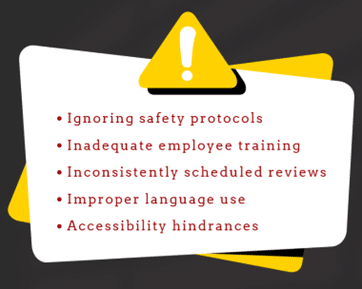Common Mistakes to Avoid in SOP Writing
August 21, 2024
As you might already know, our team at The Writers For Hire likes to compare and think of a business’s SOPs as akin to a building’s structural support. Accordingly, both are essential for success and longevity.
Think about it: If a building’s structural support is weak, it might collapse and cause severe damage and long-reaching repercussions. Similarly, SOPs of poor quality can cause critical problems within the organization and even problems that ripple outward, like legality issues.
The overarching challenge for businesses creating SOPs is that there is (quite literally) nothing short of a panoply of ways to potentially jeopardize their quality. That being said, there are five risk areas that many organizations tend to struggle with: ignoring safety protocols, inadequate employee training, inconsistently scheduled reviews, improper language use, and accessibility hindrances.

Fortunately, this is your handy guide to identifying and avoiding common pitfalls when creating SOPs. And here’s your first SOP development tip: Be sure to bookmark this page for easy reference, so you can always avoid these all-too-common mistakes! (You might even say it would be a mistake not to bookmark this page. Wink.)
Ignoring Safety Protocols
SOPs are all about establishing clear and effective procedures, but without a strong emphasis on safety, they can seem more like suggestions rather than rules. However, failing to integrate comprehensive safety procedures or emergency response protocols into your organization’s SOPs can lead to significant risks, including accidents and non-compliance issues with regulatory standards.
Thus, safety protocols essentially represent the backbone of any robust SOP. So how can you avoid the related risks of ignoring safety protocols?
Avoidance Strategies
Your overarching tactic is straightforward enough: Include safety protocols in every SOP! That being said, it’s crucial to conduct thorough risk assessments before you even begin writing an SOP. In addition, we suggest consulting with safety professionals and legal experts to ensure that your SOPs comply with relevant regulations.
Be sure to clearly detail the necessary safety procedures, and ensure the protocols are robust and of high quality by regularly conducting SOP reviews to reflect new safety standards.
Inadequate Employee Training
Are you familiar with the saying, “You reap what you sow”? You’ve likely heard it at least a handful of times, and that’s due to its broad applicability. But when it comes to training your workforce about SOPs, it stands to reason that this saying is especially relevant.
Even the most well-written SOPs can fall flat if employees are not adequately trained to follow them. It can be tempting to assume that employees will intuitively understand an SOP, but without proper training, employees can misinterpret the procedures or even not follow them at all.
Avoidance Strategies
We suggest implementing comprehensive SOP training programs that utilize a variety of approaches. For instance, your organization can institute hands-on workshops, online comprehension quizzes, and supervised practice sessions. On top of initial training, it’s also wise to conduct regular SOP refresher training sessions and assessments to verify that employees are properly following work processes.
Inconsistent SOP Reviews
Businesses are dynamic entities, and this means that their processes are constantly evolving. For instance, as new technologies emerge, regulations change, and SOP best practices accordingly shift.
If you create an SOP and then never touch it again, it’s at risk of quickly becoming outdated and irrelevant. Worse, an out-of-date SOP can represent a completely inaccurate representation of the process at hand.
From an internal perspective, an old SOP might not reflect important process improvements and innovations.

From an external perspective, on the other hand, an outdated SOP might lack critical modifications due to changed regulations or industry updates.
Avoidance Strategies
To avoid your business’s SOPs from becoming stagnant, it’s imperative to implement strict prevention strategies. Our team at The Writers For Hire suggests setting up an SOP review schedule with consistent review intervals and creating a team specifically for conducting these reviews. Furthermore, it’s best practice to implement a feedback system so employees can easily indicate whenever a change or update should be made to an SOP.
Improper Language
Have you ever tried using a manual for a new tech device or appliance that wasn’t well-written or lacked intuitive formatting? Talk about frustrating!
The same goes for SOPs in the workplace: Clarity is key. This applies to both the language and formatting of an SOP document, as jargon-filled, inconsistently formatted SOPs will only confuse your employees and hinder their ability to follow the procedures.
Avoidance Strategies
It’s important to make sure your SOPs strictly reflect their intended scope—you want to avoid including any irrelevant or unnecessary information that makes the document ambiguous or overly complex and confusing. Remember to use clear, concise language and consistent formatting as you work on SOP development. We suggest working with employees across the organization to ensure the SOP is straightforward and easy to understand.
Accessibility Hindrances
It’s absolutely essential for all employees to have constant, ongoing access to SOPs from anywhere. Accordingly, it’s wise to avoid limiting SOPs to only physical, paper formats.
For instance, if your business only uses paper SOPs and doesn’t have a dedicated electronic storage system, the documents risk getting damaged or even lost. Moreover, paper SOPs can easily lead to inconsistently documented updates and versions.

Yet paper SOPs also present other challenges.
For example, they’re not very practical for large businesses with big office spaces—employees stand to lose valuable time running around trying to locate an SOP that could be spent actually executing the associated process.
As for companies with remote employees, well, it’s not hard to see why paper SOPs would be especially problematic.
But perhaps most importantly, paper SOPs just aren’t an inclusive option for any business. It’s critical to provide a range of accessibility options so that all employees, including those with disabilities, can utilize the documented information.
Avoidance Strategies
We strongly encourage your organization to utilize a central, digital platform to store all SOPs. In addition, an SOP best practice is to offer access in multiple formats. Use a platform that supports printing for employees who prefer paper copies, is mobile-friendly, and supports accessibility tools like screen readers.
Avoid SOP Mistakes with The Writers For Hire
SOPs are no trivial matter, and they require careful attention and tenacity. With this guide in hand, businesses like yours can create high-quality SOPs that facilitate smooth and successful operations.
But we know that running a business takes a lot of time and effort, and sometimes it’s better to get some outside help. That’s why The Writers For Hire team is here to help you shoulder the SOP development workload. With our help, you can trust that your SOPs are effective, accessible, and created with careful attention to detail. Make no mistake, The Writers For Hire has your back!






























